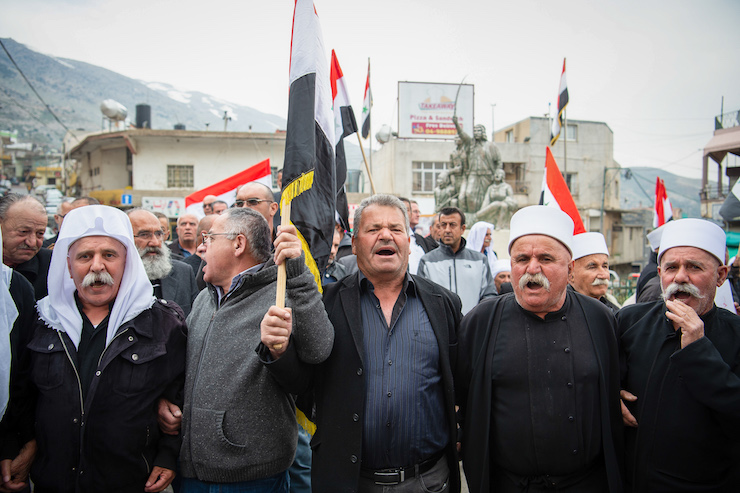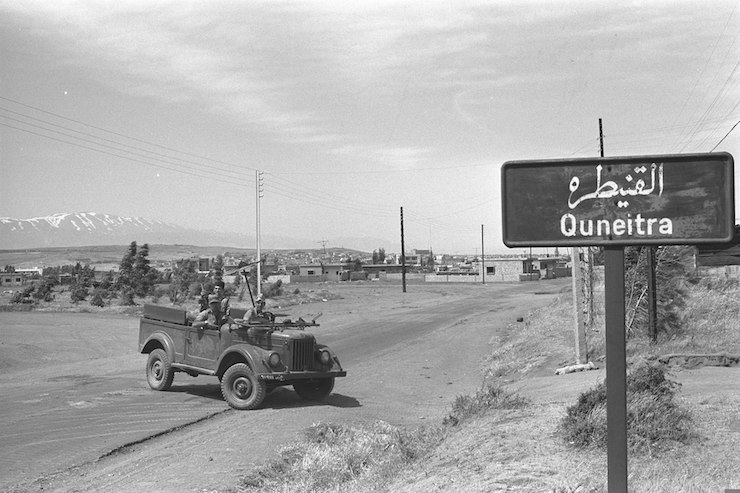President Trump’s recognition of Israel’s annexation of the Golan Heights has been widely celebrated by Israelis. But do those same Israelis know of the hundreds of thousands of people expelled from the territory during the 1967 war?
By Tom Pessah

The vast majority of Israelis are still unaware that over 130,000 residents of the Golan Heights were expelled from their villages, towns, and cities during the 1967 war. In fact, over the past decades, the territory has become a “consensus” issue among most Israelis, with many seeing no reason to return it. So while President Trump stunned the world last week by recognizing Israel’s annexation of the Golan, in Israel almost everyone celebrated the move.
Like in the case of Palestinian refugees, for decades the official Israeli line was that the Golan’s inhabitants simply fled of their own accord. According to Syrian estimates, however, only approximately 50,000 of them escaped Israeli bombardments and left alongside the retreating Syrian army. Israeli soldiers admitted in interviews that many residents stayed behind and waited to return to their villages, while others attempted to re-cross the armistice lines.
The IDF would turn to the same methods used against Palestinians in 1948 to prevent the return of the new refugees to their homes — razing entire villages to the ground, driving out the residents, and shooting “infiltrators.” Whether through direct expulsion or prevention of return, Israel was effectively ethnically cleansing the Golan.
Many of the refugees remain on the Syrian side of the border, in the Damascus and Dara areas, leaving them vulnearable to the deadly impact of the civil war in the country. According to Al-Marsad Arab Human Rights Centre in the Golan Heights, the current number of refugees and their descendants is estimated at 500,000.
Only one group was permitted to remain: between 6,000-7,000 Syrian Druze, who mostly live in four villages in the northern Golan, many of whom have relatives in Syria who are not permitted to return to their villages. The Israeli authorities assumed that following the 1967 war, the Golan Druze would become loyal Israeli citizens, echoing the decision made by the Druze leadership inside Israel in 1948. In practice, the Golan Druze have been resisting Israeli control for over 50 years. Today there are 22,000 Druze in the Golan, but only 1,700 have accepted Israeli citizenship, and the residents there continue to protest the occupation of their land, with many imprisoned for their political activities.

Israel would eventually annex the Golan in 1981, a decision that, until Trump’s recent announcement, was universally condemned. Following annexation, the Israeli authorities attempted to force the local residents to carry an Israeli I.D. card. The Golan Druze responded with a six-month general strike, which included protests and public burnings of the government-issued cards. Druze working in various industries in northern Israel preferred to lose their jobs than violate the strike. According to one source, Israeli soldiers were ordered to shoot at protesters — a command they refused. Despite imposing a curfew, cutting the residents’ telephone access, and preventing the entry of journalists and doctors, the Israeli government was forced to reach an agreement with the residents and to issue cards with an “unspecified citizenship,” rather than an Israeli one.
In the meantime, the Israeli government was hard at work in building settlements across the newly-occupied territory. Today, the Golan’s Jewish population consists of some 22,000 settlers living in 32 settlements (unlike those in the West Bank, Israelis do not typically refer to the Jewish localities in the Golan Heights as settlements). Each of those settlements was built on the land of former Syrian towns and villages, of which there are still visible ruins.
Israel has reportedly offered several times to return some of the Golan to Syria during previous rounds of peace negotiations, yet no agreement has ever been reached (Netanyahu reportedly discussed a withdrawal to 1967 lines in 2010).
Today, Israel still maintains restrictive residency rules, while continuing to demolish homes and confiscate land from the Golan Druze. The Israeli authorities have also revoked the residency of around 100 Druze, and have refused to clear the area of landmines — relics of the 1967 war, which repeatedly claim lives — while ensuring the separation of families on both sides of the border. Rather than maintaining internal “consensus” on the Golan Heights, both Israel’s leaders and citizens should be paying more attention to the voices of those most affected by Trump’s announcement.
Tom Pessah is an Israeli sociologist and activist.
